BASIC SHAOLIN COMBAT SEQUENCES
Listed below are video clips showing the 16 basic combat sequences in our Shaolin Kungfu. They are comprehensive, covering all the four categories of attack and defence, namely:
- striking
- kicking
- felling
- qin-na (gripping)
However, it is important to realize that merely knowing the techniques of the combat sequences cannot make you combat efficient. You need to develop combat skills, including going into correct forms spontaneously, reasonable force and good speed.
Other important skills include fluidity of movement, being relaxed and calm, quick decision making, and breath control. All these skills are learnt in the Intensive Shaolin Kungfu Course as well as in regular classes conducted by our certified instructors.
Those intending to attend the Intensive Shaolin Kungfu Course should familiarize themselves with these 16 combat sequences. They are the basic material used to develop these combat skills.
A common question many students ask is as follows. "I don't have a sparring partner at home. After attending an Intensive Shaolin Kungfu Course, can I be efficient in sparring or actual fighting?"
Yes, you can, if you continue to practice what you have learnt at the course. These 16 basic combat sequences will form the core of your combat training. The other important aspect of training is to develop internal force.
Another common question is as follows. "These 16 combat sequences follow kungfu forms. Will I be combat efficient if my opponent uses non-kungfu forms or free style fighting?"
Yes, you will still be combat efficient. The kungfu forms used by your sparring partner in the combat sequences represent the most advantageous ways to attack or defend in given combat situations. For example, if your opponent wishes to strike your mid body, he will have the best advantages for this combat purpose if he uses a form like "Black Tiger Steals Heart".
If he strikes you while standing with feet apart instead of using the Bow-Arrow Stance, or throwing his body-weight forward instead of using spiral force generated from his dan tian, he would deprive himself of certain advantages as well as acquire certain disadvantages. For example, it would be difficult for him to apply internal force which not only gives him more striking power but also stamina to last longer in combat, he would also have poor balance and expose vital spots to you for counter-strikes. Hence, if you are trained to fight with an opponent who uses forms that give him the best advantages, it would be easier to fight with one who is ignorant of such advantages.
However, initially you may not be familiar with the non-kungfu forms used by your opponents. Hence, you may have some initial setbacks. But once you have spent some time familiarizing yourself fighting against those using non-kungfu forms or free style fighting, you will find it is actually easier to fight against them, as many of our Shaolin Wahnam students have found from their direct experience.
This does not mean that a kungfu exponent will necessarily beat an opponent using free style fighting. Techniques are only one aspect of combat. If the kungfu exponent has trained for only a year, and his opponent fighting free style has been doing so for ten years, the kungfu exponent will have little chance against his more experienced opponent. But if both have trained for about the same length of time, if other things were equal, the kungfu exponent will have a very good chance of victory.
However, if the kungfu exponent has trained for less than a year, he may be beaten by a free style fighter. This is because it takes some time for the kungfu exponent to be able to use his kungfu forms skilfully. Before he is skilful, the more sophisticated kungfu techniques may be a liability instead of an asset. On the other hand, if he only learns forms but never practices combat application and never develops force, he will be beaten by any fighters no matter how he may have trained. This, sadly, is the case of the great majority of kungfu practitioners today.
The 16 Basic Shaolin Combat Sequences
- Black Tiger Steals Heart
- Poisonous Snake Shoots Venom
- Precious Duck Swims through Lotus
- Hang a Golden Star at a Corner
- Fierce Tiger Speeds through Valley
- Dark Dragon Draws Water
- Chop the Hua Mountain
- Horizontally Sweep a Thousand Armies
- Happy Bird Hops up Branch
- White Horse Presents Hoof
- Yellow Bird Plays with Water
- Naughty Monkey Kicks at Tree
- Fell Tree with Roots
- Lead Horse Back to Stable
- Farmer Hoes Rice Field
- Fierce Tiger Pushes Mountain
Sequence 1: Black Tiger Steals Heart
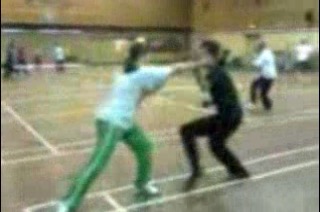
This sequence looks simple, but anyone thinking that he can be proficient in this sequence by merely knowing the attack and defence moves, which actually can be learnt in less than 5 minutes, will have missed the essence of combat training. This sequence is very important in developing fundamental skills like good timing and good spacing. It also develops fluidity of movement and breath control. You may learn the attack and defence techniques in 5 minutes, but may need at least 5 months of consistent practice to be reasonably proficient in those skills.
A picture series showing the sequence and its philosophy can be found here.Sequence 2: Poisonous Snake Shoots Venom
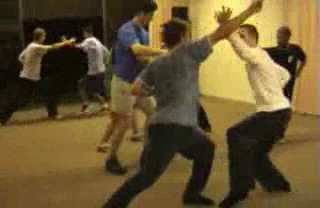
In the first combat sequence, both the attack and the defence patterns are fixed so that students need not worry about what patterns to use next and therefore can focus on developing skills. Next, a choice is allowed. In the attack, the initiator may use a high attack, "Poisonous Snake Shoots Venom", instead of the middle attack, "Black Tiger Steals Heart". The responder has to respond accordingly. If he makes a mistake, he makes an instant change.
A picture series showing the sequence and its philosophy can be found here.Sequence 3: Precious Duck Swims through Lotus
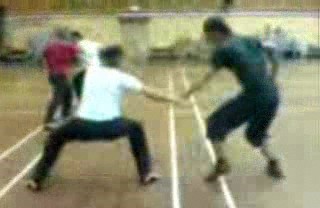
Two important skills, footwork adjustment and coverage for safety, are introduced in this sequence. If the initiator does not adjust his footwork before moving forward to execute a low punch, he would expose himself to a dangerous counter-strike from his opponent. He must also cover himself as he attacks. The responder uses the tactic of "no defence direct counter", striking the attacker's wrist or elbow as he attacks.
A picture series showing the sequence and its philosophy can be found here.Sequence 4: Hang a Golden Star at a Corner
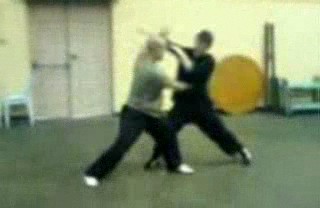
This is a close-quarter attack to a side, thus completing the four directions of striking, namely top, middle, bottom and sides (left and right). There are certain innate setbacks in a close-quarter attack like this one, and the student should realize them right at a start. One innate weakness is the risky exposure to the eyes, which the initiator must protect with his "guard hand". If the responder attempts to exploit this weakness, the initiator may change this weakness into an advantage.
A picture series showing the sequence and its philosophy can be found here.Sequence 5: Fierce Tiger Speeds through Valley
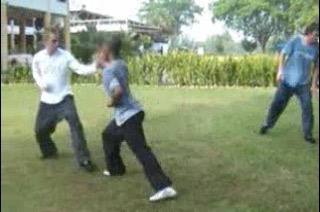
Sequences 1 to 4 are specially meant to develop fundamental combat skills. They also mainly use the left leg mode. Having acquired these fundamental skills, students are introduced to more variety of hand strikes found in Sequences 5 to 8, which mainly use the right leg mode. These sequences also introduce the tactic of pressing attacks. In Sequence 5 the pressing attacks are executed with "lin wan pau", or "continuous cannon punches". Please note that the "cannon punches" here are "straight cannons", in contrast with "toong thien pau" or "skyward cannons".
A picture series showing the sequence and its philosophy can be found here.Sequence 6: Dark Dragon Draws Water

Sequence 6 introduces the left hand palm strike, which can be a deadly combat-ending strike. Initially students learn this attack in three steps, but gradually progress to only one step at later stages. The counter against this palm strike is beautiful, and often catches an opponent by surprise, without him realizing the counter until it hits him. The crucial movement of this beautiful counter is in the rotation of the waist, and not in the blocking of the hands.
A picture series showing the sequence and its philosophy can be found here.Sequence 7: Chop the Hua Mountain

The initiator must cover the responder's hand while moving in to attack. As in "Hang a Golden Star", he must have his "guard hand" when striking with "Chop the Hua Mountain", otherwise he would expose himself to dangerous counter-strikes. The responder does not block the chopping attack, in which case his arm might be fractured by the chop; he intercepts the attack, which may break the attacker's arm or dislocate his elbow.
A picture series showing the sequence and its philosophy can be found here.Sequence 8: Horizontally Sweep a Thousand Armies

This is a fairly advanced sequence where you tempt an opponent to attack you and then strike him twice when he attacks. The counter is also quite advanced, breaking the attacker's elbow and then his ribs. Good body-work and foot-work are needed for these skills and techniques.
A picture series showing the sequence and its philosophy can be found here.
Sequence 9: Happy Bird Hops up Branch

While Sequences 1 to 8 focus on hand strikes, Sequences 9 to 12 focus on kicks. The initiator in Sequence 9 initiates with two pressing attacks, then purposely hesitate with a partially exposed body to tempt the opponent to counter attacks. When he does, the initiator responds with "Happy Bird Hops up Branch".
A picture series showing the sequence and its philosophy can be found here.Sequence 10: White Horse Presents Hoof
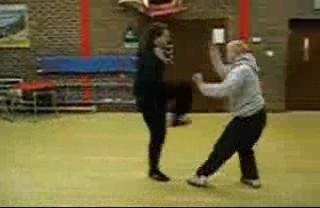
This is a progression of Sequence 9. If you tempt your opponent to attack but he hesitates, you may continue with "White Horse Presents Hoof". A good counter against this frontal thrust kick is "Save Emperor with a Single Whip", fracturing the attacker's leg as his kick reaches its full extent. When you pull back your leg and counter with a leopard punch, remember to tame the opponent's hand, otherwise he may jab into you as you lean forward to attack.
A picture series showing the sequence and its philosophy can be found here.Sequence 11: Yellow Bird Plays with Water
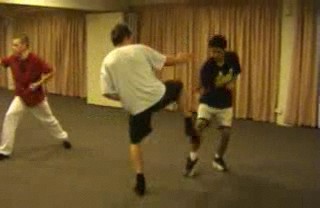
This is an effective way to stop a pressing attack, and counter with a deadly organ-kick. If the opponent blocks your kick, you may strike his eyes with your dragon hand-form. A good counter against this double-prong attack is just to move back a step, and strike the attacking leg with a hand sweep. You need not worry about the top attack as you have moved away from the attack. In life too, when a situation appears formidable while you are in it, you can often find a suitable solution to the problem if you just take a step back.
A picture series showing the sequence and its philosophy can be found here.Sequence 12: Naughty Monkey Kicks at Tree
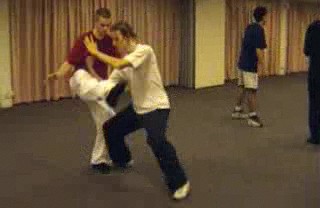
This kicking technique in Sequence 12 is called a "whirlwind kick", and is executed here in the pattern "Naughty Monkey Kicks at Tree". Although it appears like a "round-house kick", it is actually quite different. It is more flexible as the kick is executed from the knee instead of from the hips. The counter here, "Bar the Big Boss", is "hard", and may leave the head exposed which needs to be taken care of. This counter is not a block, but an interception which may cause much damage to the opponent when struck at a vital point at his knee. A "soft" approach is to use "Tame Tiger with String of Beads".
A picture series showing the sequence and its philosophy can be found here.Sequence 13: Fell Tree with Roots
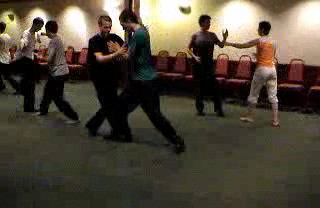
Combat Sequences 13 to 16 are more advanced and involved felling and qin-na or gripping techniques. Felling and gripping techniques are more advanced because they require more moves for their successful implementation, whereas strikes and kicks are usually implemented in one or two moves. You must prevent an opponent striking you, and you off-set his balance before throwing him. To neutralize the throw successfully in Sequence 13, the unicorn step must be performed correctly.
A picture series showing the sequence and its philosophy can be found here.Sequence 14: Lead Horse Back to Stable
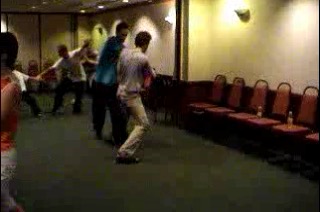
If you wish to apply a right-mode throw using "Felling Tree with Roots", your opponent should be in his right-leg mode. You still can apply this throw if he is in his left-leg mode, but applying "Lead Horse Back to Stable" may be more advantageous. "Lead Horse Back to Stable" is both a felling and gripping attack, and depending on the opponent's movement, you may lead backward or forward. A beautiful counter is "Hide Flowers in Sleeves", neutralizing the throw, releasing the grips and striking the opponent often with him not realizing where the strike came from.
A picture series showing the sequence and its philosophy can be found here.Sequence 15: Farmer Hoes Rice Field
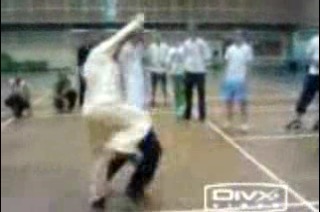
This technique, "Farmer Hoes Rice Field", is both a gripping and felling attack. This shoulder throw can be combat-ending, resulting in breaking an opponent's spine and causing him paralysis. So, do be very careful even when using on an opponent in a real fight. You wouldn't want to break his spine and regret for life. It is therefore sufficient for him to fall over your hip than over your shoulder.
A picture series showing the sequence and its philosophy can be found here.Sequence 16: Fierce Tiger Pushes Mountain
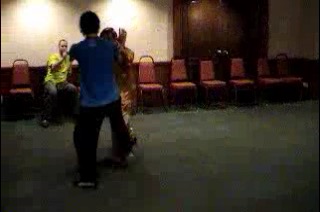
In Sequence 16 the initiator pushes an opponent away, which is "letting mercy runs from the hands", using "Fierce Tiger Pushes Mountain". He could strike the opponent with double palms, which would cause more damage. It is important to cover yourself from possible counter-strikes before you push your opponent. An effective counter is "White Horse Presents Hoof", deflecting the push and executing a frontal thrust kick.
A picture series showing the sequence and its philosophy can be found here.
LINKS
Related Pages
- Video Overview of all Sixteen Combat Sequences
- Sixteen Combat Sequences and Five Kungfu Sets — Video Series
- Themes in Shaolin Combat Sequences
- Eight Distilled Combat Sequences
- Four Abridged Combat Sequences
